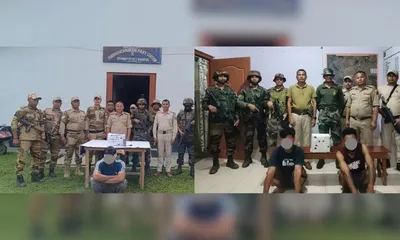Manipur: Three Smugglers Nabbed, Heroin & Vehicles Seized in Bishnupur
Short Summary
Security forces in Manipur’s Bishnupur district carried out back-to-back anti-narcotics operations that led to the arrest of three alleged drug smugglers and the seizure of heroin packed in 33 “soap cases,” two vehicles, and multiple phones. According to reports, an initial chase near Kwakta Sabal Leikai on NH-02 (Tiddim Road) yielded one suspect with 10 soap cases (about 113 g); his spot interrogation triggered a follow-up operation at Kwakta Terakhongshangbi Bazar, where two more suspects were caught with 22 soap cases (about 256 g). In total, authorities recovered ~369 g of suspected heroin, along with two four-wheelers and three communication devices. The actions were conducted jointly by Assam Rifles and local police under Phougakchao Ikhai and Moirang police jurisdictions.
The Big Picture: Why This Bust Matters Right Now
If you’ve been following developments in Manipur, you already know the state is grappling with a complex mix of security challenges and social stressors, and the narcotics trade keeps threading through that picture like a stubborn stain. Every few weeks, there’s another police bulletin: arrests here, seizures there, soap cases everywhere. It’s not just “another” bust—these operations chip away at networks that thrive on speed, secrecy, and porous borders.
In this latest case from Bishnupur, the numbers may not be eye-popping when compared with multi-kilo seizures, but the pattern is crucial: quick intelligence, rapid pursuit, immediate interrogation, and a second, near-immediate follow-up raid. That operational cadence—catch, question, capitalize—speaks to an increasingly nimble law enforcement posture. The details from local reporting show how the two linked actions unfolded within hours and within a short geographic radius.
What Triggered the First Interception?
Officers say it started with a tip-off and a suspicious rider near Kwakta Sabal Leikai along NH-02 (Tiddim Road). A joint team of Assam Rifles and local police moved in, pursued the individual, and apprehended him. The suspect was identified as Md. Arub Khan Ipham (aka “Khansa,” 26) from Kwakta Khuman Ward No. 5. On searching, the team allegedly recovered 10 soap cases of heroin (≈113 grams), a four-wheeler, and a mobile phone. The location and the quantities match across multiple outlets, which strengthens the reliability of the core facts.
The Follow-Up Raid That Netted Two More Suspects
Here’s where timing shines. On-the-spot interrogation of the first suspect reportedly yielded leads that pushed the team to launch a second operation—this time at Kwakta Terakhongshangbi Bazar, also along NH-02, but under Moirang Police Station. Two men—Md. Najeruddin (aka “Babu” Phisubam, 42) and Md. Altab Khan (aka “Boy” Moijingmayum, 31), both from Kwakta Ward No. 8 (KMC)—were detained. From them, officials say they recovered 22 more soap cases (≈256 grams), two mobile phones, and another four-wheeler. Add the two operations together and you reach the total of ≈369 grams across 33 soap cases.
FAQs
1) Who conducted the operations, and where exactly did they take place?
The actions were joint operations led by Assam Rifles and local police in Bishnupur district, specifically near Kwakta Sabal Leikai and Kwakta Terakhongshangbi Bazar along NH-02 (Tiddim Road).
2) How much heroin was seized, and how was it packed?
Authorities recovered ≈369 grams of suspected heroin packaged in 33 “soap cases”—a common method used by traffickers because it’s compact and easy to conceal.
3) Who are the arrested individuals?
Reports identify them as Md. Arub Khan Ipham (26) of Kwakta Khuman Ward No. 5, and Md. Najeruddin (42) and Md. Altab Khan (31) of Kwakta Ward No. 8 (KMC).
4) Why is NH-02 repeatedly mentioned in Manipur drug cases?
Because it’s a busy arterial corridor. High traffic offers cover for smugglers, which is why you see surprise checks and area domination exercises along this route. (Multiple recent crackdowns across Manipur have similarly targeted busy corridors and hubs.)
5) What happens next in such cases?
Police typically pursue digital forensics on phones, vehicle tracking, and link analysis to identify handlers and financiers. The case proceeds under the NDPS Act, where quantity, role, and intent influence bail and sentencing outcomes. (Case-specific legal advice would come only from authorized legal counsel.)


